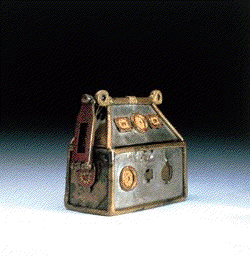|
| |
 |
Friends of
Grampian Stones
Breacbannoch of Columba |
 |
 |
Monymusk Reliquary, now in the Museum of
Scotland,
probably dating from the 8th century, was brought from Iona to Pictland and housed a relic
of the island's founder Saint Columba.
It is mentioned in 12th century charters at Forglen near Turriff, where it was kept on
behalf of the Monastery of Abirbrothock (Arbroath) with permission from William the Lion,
King of Scotland granted in a Deed dated between 1178-1214 held in Arbroath Charter Chest.
It remained in the custodianship of Forglen until the early 16th century when Forglen and
the House of Monymusk were in Forbes hands; with transfer of ownership from Sir William
Forbes, Bart. to Lord Cullen (Senator of the College of Justice, Sir Francis Grant of
Cullen) in 1712, the shrine became part of the Grant collection. It was bought for the
Nation in 1933. |
Breac-bannoch in Gaelic means the 'speckled peaked
one' describing the Reliquary's Pictish decoration punched into silver panels which form a
background of zoomorphic figures into which have been set bronze round, square and
bird-beak shaped clasps. This 'speckling' is typical of monastic / Pictish decorative work
found in 8th century jewellery, ritual ornament and religious scrollwork. The original
silver coating of the tiny wooden casket was gilded and its raised bronze mounts set with
enamel and lapis lazuli. It is smaller than a man's hand, carved out of a single piece of
wood: 4-1/4 inches long by 2-1/8 inches in height to the opening of the lid, by 2 inches
deep. The ark-shaped lid is trapezoid, 1-3/4 inches high by 2-1/2 inches along the ridge,
its gable ends forming equilateral triangles of 1-3/4 inches per side.
Its miniature scale (above illustration is approximately life-size) made it a portable
shrine worn round the neck, usually by a guardian monk. Its association with Columba, the
warrior saint, was believed to transmit the same potency in battle and the shrine was
paraded before the Scots army prior to the Battle of Bannockburn, 1314. It is not unique
in its use as a battle standard: both the relics (bone) and the crosier - baculum -
of a saint were considered potent in vanquishing the enemy. It may be for this very reason
that the Scots Chronicles record first king of both Picts and Scots, Cinaed (Kenneth) mac
Alpin, sometime before AD849 transporting relics of Columba from Iona to a religious
foundation in Dunkeld near his recently-conquered palace at Forteviot, former capital of
the Pictish Kingdom. This may have been an effort on his part to display power through the
saint and he may have taken over the foundation at Dunkeld because it was previously a
powerful ecclesiastical centre founded by the long-reigning and well-loved Pictish king,
Constantine [Custantin], who died AD820, 20 years before the MacAlpin takeover see Dupplin page
The house-shape of such reliquaries seems to have influenced later medieval 'sacrament
houses' built into pre-Reformation churches in Scotland to keep holy vessels used in the
sacrament.
© 1999-2000 Marian Youngblood
Also found at Monymusk is the unusual Pictish Cross Slab
 is
a non-profit charitable organization registered in Scotland with the Capital Taxes Office
number ED/455/89/JP is
a non-profit charitable organization registered in Scotland with the Capital Taxes Office
number ED/455/89/JP
©1998, 1999, 2000 Friends of Grampian Stones
Editor: Marian Youngblood
|
Return to
Friends of Grampian Stones Index Page
|

